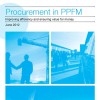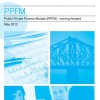This paper is the third in ACE’s infrastructure investment series and explores in more detail improvement that could be made to the procurement within Public and Private Finance Models (PPFM).
Issues explored in this paper include the concept of flexibility, transparency and the use of a centralised resource to improve procurement efficiency and reactiveness, resulting in better overall value for money for the taxpayer.
The paper explores and has recommendations in the following areas:
- There needs to be clear guidance on model suitability
- Centralised efficiency and skills retention are important
- The two broad procurement phases, provide limited information or confidence to the market
- Implementing a Procurement Efficiency Mechanism (PEM)
- There needs to be improved accountability
- Procurement issues expand beyond that of Public Private Finance Models
- Design and exploratory work can save time and money
- Flexibility is required for government to gain better efficiency and value for money
- Provide a baseline, creating a fixed operational performance will provide certainty
- Dynamic operational performance, providing capacity and efficiency beyond the baseline
Company website:
http://www.acenet.co.uk/


